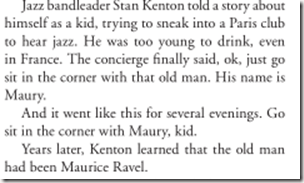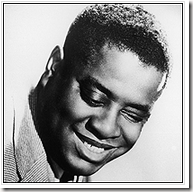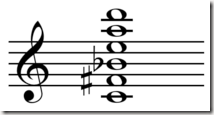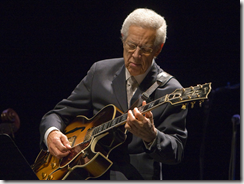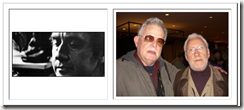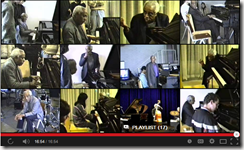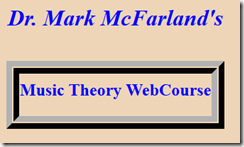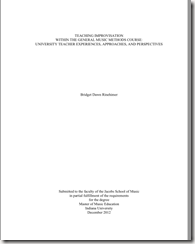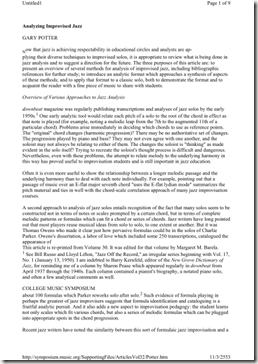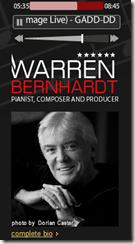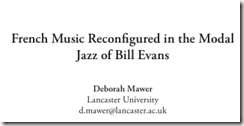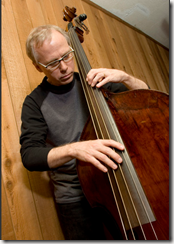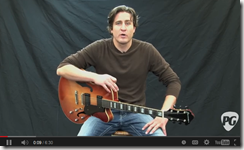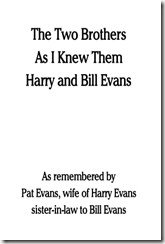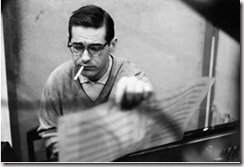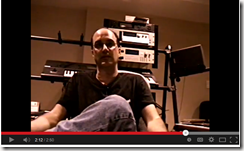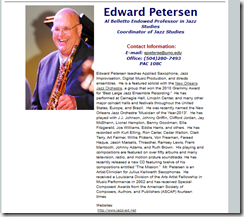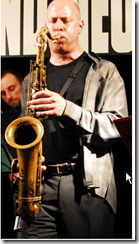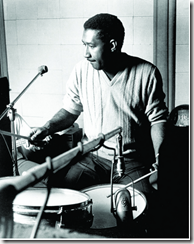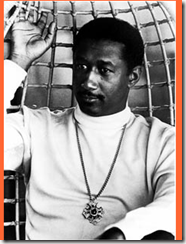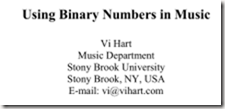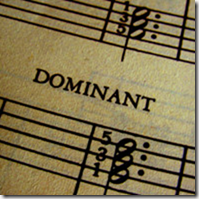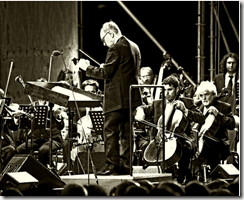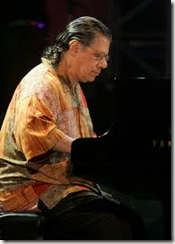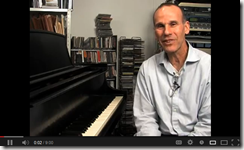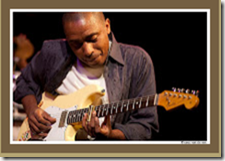I’ve read the comments Bob Dylan gave at the MusiCares benefit in LA last Friday. As others noted, there’s lots of critic bashing and other things that to me seemed a little petty. However, it’s a great speech because Bob opened up about his influences and about the way he approached songwriting. Bob hasn’t talked this much since the 60s!
I especially enjoyed this part:
I learned lyrics and how to write them from listening to folk songs. And I played them, and I met other people that played them, back when nobody was doing it. Sang nothing but these folk songs, and they gave me the code for everything that’s fair game, that everything belongs to everyone. For three or four years, all I listened to were folk standards. I went to sleep singing folk songs. I sang them everywhere, clubs, parties, bars, coffeehouses, fields, festivals. And I met other singers along the way who did the same thing and we just learned songs from each other. I could learn one song and sing it next in an hour if I’d heard it just once.
If you sang "John Henry" as many times as me – "John Henry was a steel-driving man / Died with a hammer in his hand / John Henry said a man ain’t nothin’ but a man / Before I let that steam drill drive me down / I’ll die with that hammer in my hand." If you had sung that song as many times as I did, you’d have written "How many roads must a man walk down?" too.
I love the fact that you get to see where his inspiration comes from — and he lets you know which songs inspired his songs. He gives several examples like the one above.
This is what artists are supposed to do. More experienced artists owe it to younger artists to help them understand how to develop their craft and what influences to turn to. Bob lets us know that his compositions are grounded in the past and that they didn’t fall out of the sky. One is reminded of Isaac Newton’s statement: "If I have seen further it is by standing on the shoulders of giants."
Art is generally the process of analysis (breaking down something in order to understand it) and synthesis (putting together component parts in a new and innovate way). In doing so, Bob created works of lasting value.
In my opinion, the artist whose tools are simple — voice and guitar in this case — is sadly missed. There was and is a sincerity there that is missing in modern music.
Tom Dowd was one of the greatest recording engineer / producers ever — he played such an important role in the studio with so many great artists.
http://www.prosoundweb.com/article/print/repfilesaninterviewwithlegendaryengineerproducertomdowd

From the interview — here he’s talking about one of my favorite artists — Aretha Franklin:
PL: I’d really like you to elaborate on something you said earlier. Let’s talk about the “limitations” and the “what they’re extra good at” of some of your artists. How about Aretha Franklin?
TD: Aretha is one of those most unusual artists. Aretha does not need a producer she needs a confidante, that’s all. She just needs somebody there when she’s singing with whom she can share what she’s trying to do.
Sometimes, when she hears back a performance that has completely captivated you, you’ll say “This is the best singing I’ve ever heard you do!” she’ll listen to it a few more times and say “I can do one better.” She means that it’s not an ego trip and it’s not theatrics. She actually knows that there’s something in there that she can do better. Aretha has an incredible facility for judging her own performance and knowing how much room there is for improvement.
PL: Would you say she has any “limitations”?
TD: No. She can do absolutely anything she wants to do.
I recently Google-searched the phrase “how to write melodies.” The results have a different perspective than searches related to ‘how to improvise.’ In fact, the strategy should be very similar.
Why is this? It’s because improvisation is ‘spur of the moment’ or ‘real-time’ composition. This ‘hurry-up’ aspect leads us to need tools to enable this type of composition. Thus we have compendiums of chord/scale charts and licks of our favorite players. But these amount to devices and do not go to the real question – how to write good melodies?
On the other hand, the classically trained musician learns about motif development but these too are devices which allow the student to gain insight and understanding but still do not answer the fundamental question – what makes a melody good vs. just ‘okay?’
I certainly don’t have the answer to this question. I’ll continue to research this and write more posts. Here are a few of the links I found in my initial search:
http://songwritertips.com/songwriting/melody-mining-how-to-write-melodies-out-of-thin-air/
http://www.wikihow.com/Compose-a-Melody
http://faculty.smu.edu/robfrank/temporalelements.htm
http://www.musicradar.com/us/tuition/tech/how-to-write-and-program-a-melody-580767#null
http://www.artofcomposing.com/melody-writing-part-2-the-tools-of-melody
http://en.wikipedia.org/wiki/Counterpoint
From the site:
In 1725 Johann Joseph Fux published Gradus ad Parnassum (Steps to Parnassus), in which he described five species:
– Note against note;
– Two notes against one;
– Four (extended by others to include three, or six, etc.) notes against one;
– Notes offset against each other (as suspensions);
– All the first four species together, as "florid" counterpoint.
A succession of later theorists quite closely imitated Fux’s seminal work, often with some small and idiosyncratic modifications in the rules.
http://www.soundonsound.com/cubase
From the site:
Here’s a collection of the most recent and previous 100 Cubase Notes monthly articles from SOUND ON SOUND magazine. The most recently-published 5 workshops are locked and accessible only to subscribers, but the others are now free for all to enjoy.
http://www.finalemusic.com/blog/dont-drop-the-ball-when-printing-your-music/
From the site:
If you take pride in your music notation and then print it out on cheap typing paper, you’re dropping the ball one yard from the end zone. When musicians are given loose sheets of music, printed one-sided on translucent paper, they can’t help but think (consciously or not) that the music it contains is similarly slapdash. When it comes to putting your music on paper, presentation plays a big part in perception, and it’s relatively easy to manage: your main paper variables are weight, color, and size.
I love this story about Maurice Ravel as a jazz fan:
Source:
http://crazyhorse.cofc.edu/wp-content/uploads/2013/05/Who-Was-Bill-Evans.pdf
Pascal is a French musician who’s done most of the transcriptions of Bill Evans’ solos. Here’s his bio and his page of links:
French pianist and teacher born in Paris, France and living in Meudon, near Paris.
After three years at the C.I.M. Jazz School in Paris, I have studied (1986-1989) at the Dick Grove School of music in Los Angeles: piano, harmony, arrangement and composition for orchestra with Dick Grove Dick Grove, Lou Levy Lou Levy , Clare Fischer Clare Fischer, David Angel, Joyce Collins Joyce Collins and others…
I have played in trio, quartet, quintet, in different contexts, and I have a teaching experience of more than twenty-five years, in private piano lessons as well as piano and harmony courses in jazz schools (namely Alan Silva’s IACP in Paris).
Hearing the pianist Bill Evans for the first time in 1965, and soon convinced he was one of the greatest masters in the history of jazz piano, I transcribed his music for more than 35 years (yes, dear Bill, you never knew it but I took private lessons with you for years and I learnt so much from you !).
At the beginning it was a way to understand the sound of his voicings, his harmonic system, his personal treatment of the standards, the architecture of his own compositions, and the amazing mixing of control and emotion at the same time which characterized his interpretations. And I discovered a magic world, a music whose perfection was really astonishing, being unwritten: I realized the music that I got on paper was richer than I could imagine when simply listening.
Then I could not help transcribing, with as much accuracy as I could.
It resulted in a good number of scores, some of which have been published. I wish the others would be made available to the Bill Evans lovers all over the world.
http://www.timothyjuddviolin.com/2014/01/13/ravel-writes-the-blues/
From the site:
French impressionist composer Maurice Ravel (1875-1937) found inspiration in the American jazz, which was sweeping Paris in the 1920s. At a time of prohibition and racial discrimination in the United States, many African-American jazz musicians settled in Paris, enjoying its liberating cosmopolitan energy. Additionally, Aaron Copland, George Gershwin and other young American composers came to study with eminent composition teacher Nadia Boulanger.
http://www.classicalmusicblogspot.com/horowitz-and-tatum-when-jazz-met-classical/
From the site:
Classical music and jazz may seem to have little to do with each other at first glance, but that hasn’t stopped there being a great respect between many of the artists working in both genres. Great musicians appreciate great musicianship and this seems to have been the basis of an unlikely friendship between the classical piano legend Vladimir Horowitz and the jazz virtuoso Art Tatum. – See more at: http://www.classicalmusicblogspot.com/horowitz-and-tatum-when-jazz-met-classical/#sthash.Xtb73Jgk.dpuf
http://en.wikipedia.org/wiki/Mystic_chord
From the site:
In music, the mystic chord or Prometheus chord is a six-note synthetic chord and its associated scale, or pitch collection; which loosely serves as the harmonic and melodic basis for some of the later pieces by Russian composer Alexander Scriabin. Scriabin, however, did not use the chord directly but rather derived material from its transpositions.
From the site:
Just before 11 o’clock on a crisp Monday night in Hollywood, 82-year-old Kenny Burrell put his Gibson guitar in its velvet-lined case and said goodnight to several members of the Los Angeles Jazz Orchestra Unlimited. He had just finished an intermission-free, two-hour-plus set with the large ensemble, as he has done once a month since the summer. Waiting patiently among the suits and smiles was a 21-year-old guitarist eager to meet his idol. When the room finally cleared, Burrell was amiable and inquisitive, talking to the young fan about music and Michigan, where he grew up.
http://jazzschoolonline.com/index.php?option=com_content&view=article&id=151&Itemid=529
From the site:
Last month we introduced you to jazz pianist Barry Harris’s approach to developing a chord voicing style based on two unique hybrid scales: the major 6 diminished scale and the minor 6 diminished scale. To recap briefly, the scales consist of two chords each: a major 6 and a diminished 7th, and a minor 6 and a diminished 7th, respectively. I hope you’ve enjoyed the exercises I’ve presented – and that you’ve practised them in all keys! The skills you develop by doing so will help you to "read into" the chord symbols you encounter on a typical fakebook chart.
The goal and beauty of this system is finding ways to move voicings along the appropriate hybrid scale in such a way that the motion leads into the next chord. Taking a II-V progression in D as an example, an Am7 flat 5 can be realized as a Cm6, which together with the Bdim7 chord forms the C minor 6 diminished scale (for a refresher, refer to Examples 6 and 10 in "Evolutionary Voicings, Part I" in the October ’98 issue). Moving a Cm6 voicing along that scale makes for a very interesting sound, and it leads nicely to the D7. Once on the D7, you could use a voicing from the Eflat minor 6 diminished scale, which is the altered scale for D7 (see Examples 10 and 11 in October).
http://www.melmartin.com/html_pages/Interviews/konitz.html
From the site:
I studied with Lennie Tristano in Chicago when I was in my late teens. I’d met him and was immediately impressed by him. He was a blind man, and the communication was unusual in that sense; but he always talked very straight with me. He was a musician/philosopher. He always had interesting insights when we got together for a lesson or a rehearsal. I didn’t know, as yet, anything about the music as an art form. But he felt and communicated that the music was a serious matter. It wasn’t a’ game or just a means for making a living; it was a life force. He got through to me because suddenly I was taking music seriously.
http://www.daveliebman.com/Feature_Articles/practice1.htm
From the site:
The following includes two different expositions of how to practice. Of course some material is duplicated but it is always useful to see multiple explanations of a subject as broad as how to practice.
http://jazzadvice.com/v7-to-i-10-options-for-expanding-your-dominant-7th-vocabulary/
From the site:
What’s the most important chord progression that you need to know as an improviser?
That’s a good question! Previously we explored some common chord relationships that you’ll encounter as an improviser, however the most important chord relationship that you need to know is V to I.
The Dominant/Tonic relationship is at the foundation of Western music from Baroque concertos, to Mahler symphonies, to Louis Armstrong, to Coltrane, to the Beatles. In nearly every standard that you’ll practice or perform as an improviser, you’re going to encounter the V7 to I chord relationship.
The Blues, Rhythm Changes, Stella by Starlight, Giant Steps, All the Things You Are…it all goes back to V7 resolving to I. If you haven’t already worked on this dominant to tonic relationship, it’s time to get started.
Barry Harris is a fantastic teacher – so inspiring – watch or subscribe to all these videos! You have to do it!
From the site:
This video is part of a collection of videos which Frans Elsen recorded during workshops that Barry Harris gave at the Royal Conservatory in The Hague between 1989 and 1998. Frans Elsen was a very important Dutch pianist, arranger and educator of Jazz. He and Barry shared a mutual appreciation of each others music and were close friends. This material has been edited and selected by Frans himself. It gives a unique insight in Barry’s wonderful ways of teaching and his extraordinary musicianship. Please visit http://www.franselsen.com for info about Frans Elsen and his musical legacy. There is a special reference to these videos on that website. These videos are an important historical document of one of Jazz music’s finest and foremost musicians and educators.
https://www.youtube.com/watch?v=vdMDKOyVZHw
From the site:
When playing behind a soloist in a modal tune, many musicians struggle to maintain interest and variety in their comping.
This video explains a comping technique that McCoy Tyner used, which will allow you to have better and more interesting interaction with a soloist on a modal tune. It’s especially useful for playing with tenor sax players.
This video won’t teach you to sound like McCoy. It will teach you the landscape on which he developed his musicality, so you can explore that landscape and develop your own voice within that world of sound.
http://www2.gsu.edu/~sommcf/webcourse/index.html
From the site:
Welcome to the GSU Music Theory WebCourse. This webcourse has been designed primarily for students who would like to brush up on their music fundamentals skills before their classes begin. The material contained in the following seventeen lessons comprises what is often referred to as "music fundamentals." Students who have had some music theory in the past—whether in high school, private lessons, or summer music camp—will be able to master all seventeen lessons with diligence. Those students who have never heard the phrase “music theory” before will still find much of the information very familiar, especially lessons 1-7.
Other links from GSU Music Professor Dr. Mark McFarland:
http://howtopractice.com/music-practice-resources/articles/music-practice-links-17th-december-2012
From the site:
It’s been quite a while since our last round up from the world of music practice on the web. In that time a few new sites dealing with music practice have arrived and we’ll be reviewing some of those in the coming weeks. For now, onto the links . . . . . .
- How to Apply Focused Practice to Music Note Reading from the Music Reading Savant
- Brief article on how to practice a cover song in stages
- Stack Exchanges forums have a section dedicated to Music Practice and Performance
- Dr B’s Music Practice Guide provides a comprehensive look at the whole topic of music practice
- Savvy lessons provides some practice tips for beginners and some motivation help
- Here’s an interesting comparison between musicians and athletes
- Music in practice presents some ideas on making music fun
- An old favourite, the Musicians Way, suggests Performance-Oriented Practice
- If you need any more persuading here are 10 reasons why you should study music
Enjoy your practice!
http://jazzadvice.com/improvising-with-chromaticism/
From the site:
As improvisers we are always looking to create new harmonic concepts or to find new ways of soloing over traditional changes that are innovative and creative. Actually, for the past sixty years jazz musicians have been playing the same basic set of standard tunes, each generation making their stylistic mark on the history of the music. This is a lot of development and after the innovations of Parker, Trane, Miles and countless others it seems like every possible way to play over these progressions has already been done…twice.
http://www.artistshousemusic.org/articles/four+approaches+to+jazz+improvisation+instruction
From the site:
This article will investigate underlying processes of improvisation using pianist Bill Evans as a model. I will also compare and contrast four master teaching styles that follow Evans’s methodology. These artists, though diverse in their teaching approaches, show a commonality of focused thought and structure at the core of their craft. It is at this juncture that artist interaction with students is most significant.
https://thepracticeofpractice.wordpress.com/about/
From the site:
A lot of attention has been given lately to how world-class experts get to be so good. Researchers are interested in this, too. I’ve personally read hundreds of research studies published in esteemed journals and conducted by trained researchers. These research reports are dense with great information. One of my goals is to translate this information into a form that is more easily (and quickly) digestible for those of us who have neither the time nor inclination nor access to this broad array of research. I’ll include video, audio, pictures, and relevant links wherever possible in an attempt to make the information more engaging and applicable.
http://www.musicreadingsavant.com/how-to-apply-focused-practice-to-music-note-reading/
From the site:
9 Tips for Making Your Music Reading Easier
Now that you’re on right on track mentally and ready to tackle this whole music note reading business, here’s a few tips on how to do it effectively:
1. Know what you want to do and where you want to go. Is this really something you want to do? Are you willing to make a commitment to yourself?
Until you get to this point, any effort you put into improving your music reading will be half-hearted and maybe even mindless activity. You will never get anywhere by doing this. Make a decision today.
2. Find a teacher. Teachers are able to design a system of practice for you detailing your immediate next steps. If you are unable to hire a teacher to work with you privately, then invest in high quality resources you can practice that stretch you beyond your current capabilities.
Make sure these materials include answers that can give you immediate feedback on how you are doing.
3. Set goals. Decide what you are going to work on today. These goals need to be specific and directed towards the process of reaching the end result and not the end result itself.
This means breaking everything down into small pieces and analyzing it. How well are you doing in these areas right now? What needs more attention?
4. Plan. How are you going to reach those goals? Right down what particular parts need to be worked on and in what order. This will give you clear direction in knowing how to get where you are going.
5. Only work on the specific areas that need improvement. Working on what you can do well is a waste of time. Spend your time identifying what is deficient and create a plan of action on how to conquer those areas.
Break everything down into small chunks, analyze it, and then practice it repeatedly.
6. Work on the weak spots diligently. Choose one small item you need to work on and rehearse it intensely. Make sure you are well rested and take away all distractions that will not allow you to focus.
7. Observe yourself closely while practicing. Step outside of yourself and monitor what is going on in your head. Ask yourself how it’s going. In other words, while you are practicing, think about what you are thinking about.
Am I pushing myself enough? Have I fully taxed out my abilities in this area? Can I move on to practicing another skill set yet? How is this working for me?
8. After you practice, evaluate the results. Be specific and don’t be afraid to write it down. You can either compare yourself to your best performance in this particular area or with an expert that has mastered it already.
Make sure you choose a comparison method that pushes you just beyond your current limits.
9. Identify your errors. Create a list of ideas on how to get better next time. Make it as detailed as possible.
http://simonpurcell.files.wordpress.com/2009/09/on-practicing-v71.pdf
From the site:
Welcome to the website of musician and educator Simon Purcell.
Most folk will know me as Head of Jazz at Trinity Laban Conservatoire of Music and Dance in London UK. Here you can read my blog, download jazz Learning Resources, hear my current Quintet, download charts of compositions, access research papers and find out about the jazz courses offered at Trinity Laban. There is plenty of information and advice here for students of the music wishing to make their practice more effective – click here.Do check out the blog and the menu items above…
Motivic strategies in improvisations by Keith Jarrett and Brad Mehldau
Schenkerian Analysis and Popular Music
Revisiting Thematic Improvisation and Form in Jazz Goal Orientation in Brad Mehladau’s Unrequited
Applying Schenkerian Theory to Mainstream Jazz A Justiffication for an Orthodox Approach
Schenkerian Analysis of Modern Jazz Question About Method
Charlie Parker Four Graphic Analysis of his Compositions
http://www2.gsu.edu/~sommcf/publications/Limits_of_Schenker.pdf
From the site:
The application of Schenkerian analysis to jazz, something that Schenker would likely have done only to prove the deficiency of the style, has become more prominent in recent years. The history of similar research stretches back to the 1970s, although these studies were relegated primarily to jazz
journals and the occasional thesis or dissertation. 1 By 1995, however, monographs on the American popular ballad and the music of Gershwin, by Forte and Gilbert, respectively, brought greater legitimacy to this line of research. These were, after all, the joint authors of the first widely-used textbook on Schenkerian theory (Forte and Gilbert 1982). Their studies suggested that these styles were not, in the words of Furtwängler (1985, 4), merely a string of intricacies that “exist for the moment in which they
sound,” but that long-range hearing could highlight the same sorts of characteristics that unify the works of the tonal masters.
http://www.warrenbernhardt.com/#EducationalMaterials
From the site:
Warren Bernhardt provides you with a wealth of musical knowledge, giving you the tools to discover what jazz piano is all about – and to really start playing.
http://www.pianoworld.com/forum/ubbthreads.php/topics/1881326/Bill%20Evans%20Documentary.html
From the site:
Never posted before but I think this 1966 documentary, "The Universal Mind of Bill Evans," is a worthy mention and some will definitely enjoy it. It was recently posted on the following website and can be viewed for free:
http://www.jazztranscriptions.co.uk/piano/
From the site:
The are several really fine piano transcription sites out there, and you should generally check my homepage for my latest transcriptions posts.
http://www2.southeastern.edu/orgs/34skid/html/23.pdf
Archives of Win’s great Letter form Evans website. As best I know, the site no longer exists. I’m thankful this has been preserved.
From the site:
Join Dave as he analyzes a recent solo performance of the great Chick Corea! Topics include modal interchange, modal anthems, ten drummers, cycled harmonies, and much more. Includes a new performance by Dave and class notes available for download.
http://innerviews.org/inner/johnson.html
From the site:
Few tribute albums are as heartfelt and imaginative as Something For You, pianist and vocalist Eliane Elias’ personal appreciation of jazz titan Bill Evans. Created in collaboration with upright bass virtuoso Marc Johnson, Evans’ bassist from 1978 to his passing in 1980, the album offers a varied and unique look at the pianist’s oeuvre. Drummer Joey Baron rounds out the album’s trio which explores well-known Evans compositions and his favorite standards infused with fresh arrangements and the occasional gorgeous Elias vocal. It also features previously unknown, unrecorded material from the legendary musician that’s sure to create a major buzz amongst jazz aficionados.
http://www.premierguitar.com/articles/Triad_Pairs
From the site:
Using triad pairs is simply an intervallic approach to improvisation. The concept is fairly basic, and it’s fun and challenging at the same time. When used correctly, the technique can generate some very interesting sounds. Let’s get started.
http://www.freejazzlessons.com/how-to-practice-jazz-for-long-term-grown/
From the site:
So, I’d like to share with you 4 of the common elements these jazz greats seemed to make a part of their practice routine.
The 4 Elements
Learning Tunes- They all had/have an incredible amount of repertoire under their belt. How do we know this? The sheer amount of tunes these greats had/have recorded. Here’s an article on jazz standard tune learning.
Transcription – They all respected the tradition and the jazz vocabulary that came before them. They all studied and transcribed the music that came before them. For example: Barry Harris (although not an inventor of bebop) has an almost encyclopedic knowledge of the bebop vocabulary. Bill Evans was thoroughly grounded in bebop, modal playing, and impressionistic classical music.
Technical Development – They all had high degrees of technical proficiency and continued to develop their chops as their careers progressed (with Oscar Peterson probably being the one with the most emphasis on this. Very few pianists could burn like Oscar). None the less, every one of these guys could play and swing their #$$es of from slow ballads to burning up tempo tunes.
Vocabulary Learning (Lick Learning) – Ever notice how Barry Harris can sound so much like Bud Powell and Thelonius Monk at times? Why is this? He’s studied a ton of their amazing vocabulary. Why do the piano runs Oscar Peterson played in early in career sound so much like Art Tatum? He learned many of Tatum’s virtuosic runs! Why does Chick Corea at times sound harmonically like Bill Evans? He’s studied Bill’s incredible sense of harmony and inner voice motion. (Need some help learning licks? Check out these lessons Barry Harris Lick, Turnaround Lick, Bud Powell Influenced Lick, Minor ii-V-i Lick, or this Bebop Lick)
http://www.stevekhan.com/books.htm
From the site:
NOW AVAILABLE!!! The book is drawn from concepts which I have been sharing with my private students, and those who have attended my clinics and master classes, for now over 30 years. Like many aspects of my early music education and jazz education, these were ideas which I came upon by myself, because during the years when I was trying to learn about such things, the mid-’60s, there wasn’t the scope of information(books, videos, play-alongs, etc.) which exists today. As there are already many fine books dealing with "jazz lines" and their formation, and various theories about how one can best "speak the linear language" of jazz, I felt that I had to narrow my focus and concentrate on one area. This book is intended to work hand-in-hand with "CHORD KHANCEPTS" and function as its linear adjunct. It is, hopefully, a relatively comprehensive study of the improvisational usage of, what I feel are, the two most common pentatonics: the minor pentatonic[R, m3rd, 4th, 5th, 7th] and what I have come to call the dominant 7th pentatonic[R, 2nd, 3rd, 5th, 7th]. In addition, the book tries to clarify the difference between the "blues scale" and the "minor pentatonic" scale. With that done, the book shows how one can then "backtrack" and put to use the blues scale over what might seem to be some pretty uncommon chord structures. It all works beautifully together in the end. The book then seeks and explains, and in great detail, how one goes about applying these simple formations to the basic harmonic "families" encountered in "jazz" or any music where improvisation is important. Any instrumentalist could benefit from the concepts in this book. If one is trying to specifically narrow it down to the guitar, well, I’d have to say that obviously those players who are trying to further develop their abilities to improvise would benefit the most. That doesn’t necessarily mean that only ‘jazz’ or ‘jazz-fusion’ players would get the most out it. The book is really geared towards everyone! It is not intended to speak over anyone’s head, nor beneath it. It appears in standard notation with TAB…..so, one could easily say that it’s a "rock"-friendly book. By that I mean, players, whose primary focus might be in rock, R&B, hip-hop, blues, country, pop, and other areas, should also be able to gain a lot from the shared information. There is yet another fantastic example/play-along CD, only one(1) this time, accompanying the book and its text. The CD features performed examples which appear in the book as well as Steve’s performance improvisations. The book can be obtained from Amazon.com, as well as Jamey Aebersold or directly from Alfred Publishing Co. at: (888) 310-3342 or online via Order Music Today.
http://www2.southeastern.edu/orgs/34skid/BEJF4/Clear_Day/
From the site:
I chose the session topic �Do Transcriptions Really Tell the Story� after learning of so many new collections of Bill Evans transcriptions on the market and my own frustration in attempting to recreate the art of Bill Evans from those transcriptions alone.� I put together a CD with all the tunes transcribed in the publication for easy reference. I am a mere bass player, not a jazz pianist, but I do encourage my wife, who can play the instrument, to read as many of these transcriptions as she has the time for because there is something very exciting about hearing the notes that Bill played in your own living room, on a decent piano. After listening to a lot of the recordings and to my wife (who listens to Bill) try to play the transcriptions, I realized that there is just as much (perhaps even more) musical material not captured by traditional music notation.� I thought it would be fun as well as educational to point out as many of these �non-written� items as possible in the hope that others and I could understand Bill�s playing and persona a little more.
http://www.keyboardmag.com/article/5-ways-to-play-like-bill-evans/2440
From the site:
It’s hard to believe it’s been 30 years since the revolutionary jazz pianist Bill Evans left us at the all too young age of 51. Evans was, and still is, among the most influential jazz pianists of the past sixty years. His effect on modern jazz piano was so profound, he actually influenced pianists whose fame both followed his own (Herbie Hancock, McCoy Tyner, and Brad Mehldau), and preceded it (Teddy Wilson, George Shearing, and Oscar Peterson). On both sides of this generational divide, pianists who heard Bill Evans altered their own playing as a result. There’s no doubt that had Bill survived to his 81st birthday, he would have added many more ways to this “five ways” list. He left it to us to add to such lists ourselves. That’s what he wanted, after all.
http://www.youtube.com/watch?feature=player_detailpage&v=hfgfo1cj_BQ
From the site:
Michael Brecker was interviewed by Bret Primack in 1996 about his then new release, Tales from the Hudson.
http://www.daveliebman.com/Feature_Articles/practice1.htm
From the site:
The following is basically (with some edits) the lecture I gave at the Jamey Aebersold Summer Workshop in Louisville, Kentucky at the end of my one day visit there in July, 2005. There is a two set DVD available through Caris Music (“David Liebman Teaches and Plays”) with this lecture in addition to another on saxophone expressive techniques. It also includes a concert featuring Rufus Reid, Dave Hazeltine, John Riley and Steve Davis. But for those who want a freebie, here’s the rap on practicing. Of course some of this material appears elsewhere in my writings over the years, but it is always good to revisit it every so often.
http://www.keyboardmag.com/article/improvise-with-intervals/148288
From the site:
INTERVALLIC IMPROVISATION LEADS TO A MORE INDIVIDUAL STYLE OF PLAYING. IT CAN HELP YOU find your own voice by forcing you to avoid familiar avenues and improvisational habits. I discovered this style by listening to jazz greats like John Coltrane, Woody Shaw, and Larry Young. Their ability to jump around a chord instead of always playing through it in scale fashion always intrigued me. Improvising on a chord progression with an interval-based approach is less predictable than the scalar alternative. Let’s examine the difference between these two approaches. On piano, it may feel more natural at first to play notes that are close to each other. Try the intervallic examples in this lesson, though, and you’ll be surprised at how easily they fit the hand—and how fresh they sound.
http://www.halgalper.com/articles/understandingforwardmotion/
From the site:
My original three articles on Forward Motion were published in Down Beat Magazine in 1980 & 1981. Their purpose was to show how melodies work as well as offering a way of practicing scales more in the manner they are used than in the way they were originally learned. Since that time my understanding of the subject has grown and the way I use FM in my teaching has been modified. Originally, I used FM to correct what I saw as a technical and theoretical problem. Now I see FM exercises as being used to correct what are basically perceptual problems. As most problems with playing music are perceptual in nature, to change the way you play you have to change the way you think.
http://www.jazzedmagazine.com/2475/articles/focus-session/the-power-of-pentatonics/
From the site:
Pentatonic scales are everywhere! They can be found in folk music from all around the world including: China, Japan, Greece, Poland, Indonesia, Ethiopia, and Scotland. American spirituals such as “Amazing Grace” and “Old Man River” utilize pentatonic scales exclusively and many rock guitar players have built their entire careers upon the five notes of the minor pentatonic scale alone. Pentatonic scales can be found throughout the music of Impressionist composers such as Maurice Ravel and Claude Debussy as well as in the music of modern jazz giants like John Coltrane, Herbie Hancock, and Chick Corea.
Kenny Werner talks about meeting Bill Evans and discussing his approach to practice.
From the site:
Kenny Werner is a world-class pianist and composer. His prolific output of compositions, recordings and publications continue to impact audiences around the world.
http://www.jackreillyjazz.com/
From the site:
In the eyes of anyone interested in the technical aspects of Bill Evans, this will make for fascinating reading and, hopefully, some challenging playing too. Reilly is the renowned teacher and performer whose students include such as Bill Charlap, and whose achievements have taken in albums as well as tours in the U.K. The fact that he also had an early acquaintance with Bill, long before the latter became famous, obviously lends weight to his intention in explain the inner mechanics of Evans’ music.
http://animationresources.org/?p=1413
From the site:
I feel that Jazz is not so much a style as it is a process of making music. It’s the process of making one minute’s music in one minute’s time. Whereas when you compose, you can make one minute’s music and take three months… We tend to think of Jazz as a stylistic medium, but we must remember that in an absolute sense, Jazz is more of a certain creative process of spontaneity than a style… Any good teacher of serious classical composition will always tell a student that the composition should sound as if it’s improvised. It should have a spontaneous quality, so actually, the art of music is the art of speaking with this spontaneous quality.
https://www.youtube.com/watch?v=OOZ7jOgxoaM#t=128
From the site:
Published on Nov 4, 2013
Mike Clark performs "Softly As In A Morning Sunrise" with students and faculty of PSU.
Nicole Glover, tenor sax
Jon Lakey bass
George Colligan piano
http://jazzadvice.com/how-to-transform-your-improvisation-over-your-summer-vacation/
From the site:
You might be a student looking to transform your playing for the next school year, a player looking to capitalize on a few extra hours of daylight, or an aspiring improviser looking to set some meaningful musical goals. Whatever your motivation, the summer is a great time to beef up your repertoire, to expand your technique, to improve your ears, and to fortify your harmonic understanding.
If approached correctly, your summer practice can transform the way you improvise.
http://jazzadvice.com/how-to-completely-learn-a-melody-in-30-minutes/
From the site:
Everybody talks about learning tunes. I mean everybody. It’s the one common thread that you hear about at jam sessions, in music schools, and conversations with great players. So much emphasis is placed upon the need for more tunes it’s not surprising that most players have this burgeoning mental complex about knowing and learning tunes that hangs over their heads day after day like a black cloud.
With this ominous mindset, the simple act of learning a tune becomes a painful, long, drawn-out process that we try to avoid at all costs.
For years, I was stuck in this mental box and would force myself to try to learn tunes by pure memorization, from a piece of paper. Hours were spent in fruitless pursuit and it became easier to read tunes than to actually learn them. When it came time to perform these tunes, I was hanging onto these mental facts like a stranded swimmer holding on to a life preserver.
If I couldn’t think of those note names I memorized or that sequence of fingerings, I had nothing to play and worse, no aural skills to keep me afloat.
When you are learning in a situation like this, building a solid repertoire can seem like an impossible task. Even when you do manage to learn a tune, are you sure that you truly know it and will remember it?
If this sounds familiar, you’ve probably had the same thought I often had: There has to be a better way to learn tunes and make them last than this!
http://www.drummagazine.com/features/post/al-jackson-jr.-the-sound-of-60s-soul/
Another good article about the great drummer Al Jackson Jr.
From the site:
On the long stream of records that issued from Stax during its glory years, roughly 1965 through ’72, musicians who filled out the fabulous Stax rhythm section, the bare-bones but in-the-pocket Memphis Horns, and the vocalists all plugged directly into the beat. There was no percussion to dress it up, and when strings were brought in for ballads they were written thin, usually in single lines or, if harmonized, with a non-intrusive intimacy (as on Eddie Floyd’s “I’ve Never Found a Girl”).
For this to work, you had to have someone behind the drums who understood the formula. The current had to flow unimpeded, at every speed; the slowest tunes needed that pulse as much as the ones that rode an up-tempo rush.
You needed a drummer who respected the air in the rhythm, who could resist the temptation to fill every hole with reminders of his virtuosity …
… resist, that is, until the perfect fill, perfectly positioned, could explode the tune — like the strike of a match.
On top of that, you needed a drummer whose tempo was perfect, who locked each take down right where it belonged but could ramp it up on stage, where live energy made it appropriate.
All of this ruled out pretty much every drummer on earth at that time save Al Jackson Jr. — and it’s everyone’s good fortune that this amazing musician, who transformed Am
http://www.funkydrummer.com/JPpages/ajinterview.html
Great interview from Jim Payne’s book I believe. Steve Cropper is the interviewee as best I know although it’s not clear from the web page.
From the site:
Al Jackson went for the meat of the groove. He knew how to study that song, and he could do it very quickly. He hated to rehearse on something, too, which used to wear us out, because we felt like we really needed a drummer to find the groove so we could be creative. But Al would say, "Yeah, y’all work it up and then I’ll come in there." We’d say, "Man, we need a drummer!" [laughs] Basically, we’d just sit in there and learn changes and then, when Al got there, we’d start trying to arrange it a little bit.
There is a difficult crossroad to face for the piano improviser with regard to fingering. Much improvisation involves split second decisions about what notes to play. These decisions are often at odds with optimal fingering. As a result, many mistakes or missteps are the result of getting oneself in a ‘bind’ – you have decided to play something but find yourself tangled up with the fingering problems that are presented by the passage you want to play. How to solve? Practice patterns without regard to fingering – i.e. ad hoc fingering? Reliance on standard fingering systems? Both have their issues.
So we are after fluidity / manual dexterity in an improvising environment. One cannot work out fingerings ahead of time as with a composed passage. One reasonable approach seems to be to develop an improvisational scheme that is more long term, less instantaneous. It is said that the greatest bebop players had the entire chorus or the entire solo planned out from the outset of the solo. This author calls this a ‘melodic roadmap’ based on building tension through the course of the solo.
Fascinating excerpts from a UK South Bank Show entitled History of Boogie Woogie. As the narrator says, “many fortunes were made” from this music. I would add that many fortunes continue to be made from this music whose African-American innovators were scarcely credited for their contribution.
From the site:
Muscle Shoals music segments from the Documentary Channel’s "TVA: Built for the People."
From the site:
Vince Gill, Dawn Sears, "Ranger Doug" Green, Kenny Sears and Dennis Crouch talk about the bands history and the making of the new record. Learn more about The Time Jumpers at http://www.TheTimeJumpers.com.
Order the new album at http://thetimejumpers.com/wired/store/.
Tap any member of The Time Jumpers on the shoulder and the face that turns to greet you will be that of one who’s made major contributions to the richness and vigor of country music.
From the site:
Have you ever been frustrated by the fact that you can take a difficult passage, work on it for a bit, get it sounding pretty good, but return to the practice room the next day to discover that you’re back at square 1? That nothing has really changed? And despite how good it sounded yesterday, now it sounds just as bad as it did before you worked on it?
Most of us can live with “two steps forward, one step back.” It’s the “two steps forward, two steps back” that makes us want to tear our hair out.
So what are we to do?
Are we just supposed to keep at it and learn how to be more patient? Or is there a different way to practice that can make these improvements more permanent?
http://www.michaelzilber.com/page/10-questions-every-aspiring-jazz-musician
From the site:
Here are some comments meant for any serious student of jazz, based on my years as a player and a teacher as well as drawing liberally from my talks with Dave Liebman.
I wanted to address the sometimes not-fully articulated question that underscores working with jazz students of a higher level, what legendary saxophonist/educator Dave Liebman calls the “keys to the kingdom” question and what I refer to as the magic scale/magic chord question: How does one break through beyond the level of journeyman to jazz artist with something to say? It is a hard and nuanced question with no easy answers.
http://www.oxfordamerican.org/articles/2013/sep/23/musician-interview-jerry-williams-jr/
From the site:
Even at the age of seventy, Jerry Williams Jr. comes off as the class clown, bragging about such mischief as sneaking a deceptively sweet-sounding description of a woman’s bad breath into the otherwise tender, and oft-covered, “She’s All I Got.” (A foul smell, he insists, is the true meaning of the line “She could kiss the ground in wintertime and make a flower grow.”) But he can’t conceal the smarts, shrewdness, and savvy beneath his eccentricity. The titular cover art he dreamed up for the album Rat On!—an image of him in polyester threads, striking a victorious pose astride a giant, white rat—has accomplished exactly what he intended: enduring notoriety. He’s pretty damn proud of the fact that it consistently lands on lists of the all-time worst album covers.
http://jazzadvice.com/the-path-to-playing-what-youre-hearing/
From the site:
These are the instructions that numerous books, videos, and educators tell us as we struggle to figure out how to play over chord progressions. The only problem in situations like these is, as beginners, we aren’t hearing anything in our heads.
http://www.thejazzresource.com/guide_tones.html
From the site:
Guide tones are an excellent way to study and absorb the sound of a chord progression. Guide tones are typically considered to be the 3rd and 7th scale degree of a chord because this is what determines whether a chord is major, minor, or dominant. Guide tones get to the center or essence of a chord progression and how it sounds moving from one chord to the next. Here are the guide tones for Autumn Leaves:
http://danhaerle.com/GuideTones.html
From the site:
Guide tone paths are very important in building good melodies when improvising. Guide tones are often color tones like 3rds or 7ths but they may be other chord tones, altered tones or extensions of the basic chords. They are generally the notes that identify the real nature of the harmony and provide a smooth flow through the harmonic progression. As jazz players, we often think of the vertical structures of the various chords in a progression. But music does not move vertically, it moves horizontally! Guide tones are the hooks you hang your melody on! The melodic curve may move up or down and all around the guide tones but they are what give it a strong forward motion!
http://jeffreychappell.com/practicing.php
From the site:
There is a basic pattern to the procedure of learning a piece of music: you confront a whole; you fragment it and get to know its parts; then you reconstruct the whole.
http://voices.yahoo.com/how-finger-dexterity-developed-piano-3248115.html?cat=33
From the site:
How is finger dexterity developed for the piano? Fingering that allows hands and fingers to move easily is a fascinating discipline developed to high levels of dexterity by teachers and performers. Whenever possible, place the five fingers on five adjacent notes and use standard scale and arpeggio fingerings. This means learning scales and arpeggio fingerings and using them in your pieces.
This is perfect – just great stuff and I wouldn’t change a thing!
I just like this – what great harmony!
From the site:
Navy Musician Ron Oates spends the day at the Parlor, his recording studio of choice with engineer John Saylor. An inside view of the process of developing talent and dealing with the business end of the music business. Plus an impromptu performance on his favorite grand. Produced at midiART Studio by Mike Beegle for the Navy Musicians Association Archives. Sample demo is "He Calls Me Baby" copyright Jus Fine Productions!
Vic Firth takes you inside a Nashville demo recording session with studio legend Paul Leim! In this video, you’ll see firsthand how a demo is recorded, from the artist’s first listen to the songwriter-produced demo to the final product.
In this clip from http://www.artistshousemusic.org – Session keyboardist Blair Masters discusses the unique experience of being a keyboard player in Nashville. He explains the importance of working quickly, knowing your gear, and having good musical taste.
http://vihart.com/papers/binary/BinaryMusic.pdf
From the site:
Binary numbers used as rhythms (not to be confused with binary rhythms) can be used in music to create a mathematical aspect to a piece which can be heard and appreciated by mathematicians, yet still be pleasant to the ears of the uninitiated. Even someone who has never heard of binary numbers can still understand the patterns on an intuitive level. Binary numbers, especially those affiliated with computer science, have a structure which goes very well with the standard forms of music.
http://www.pianocareer.com/piano-expression/piano-dynamics/
From the site:
The dynamic possibilities of the piano are amazing: from an extreme pianissimo to the greatest fortissimo and to many thousands of gradations in between!
Its tone can be soft like the summer breeze, delicate like the rustle of leaves, expressive like the sound of a violin or cello, deep as the hum of the ocean, powerful as a thunderstorm!
By learning how to create different sound intensities, how to ‘play’ with various dynamic gradations, you will take your expressive skills to a whole new level, bringing out the artistic concept of each piece in a professional, captivating manner.
http://cowboyjackclement.us/bio/interviews/Don_Robertson_LWClark.pdf
Don Robertson invented the slip-note piano style that is the hallmark of Nashville piano – it’s still the standard piano style today. The above link is an interview with Don. He was schooled in both classical and jazz in his early life. He attributes his interest in popular music (e.g. country) to the Dinning Sisters – you can hear some of the slip-note styling in some of the harmonies they are singing! Interesting…
From the site:
Songwriter/musician Robertson demonstrates the distinctive "squashed chord" piano technique that he had introduced, though it was Floyd Cramer who rode to fame on that style.
http://audio.tutsplus.com/tutorials/music-theory/using-pedal-points-basix/
From the site:
The pedal point is a common compositional device with a range of useful purposes. In this tutorial we’ll learn what a pedal point is and how it can be used for a variety of functions. We will study examples all the way from Bach to Hans Zimmer and see how different composers make use of pedal points to achieve similar goals.
I’m an Ennio fanatic now – his music is some of the greatest stuff you can find on YouTube – you won’t be disappointed!
http://www.guardian.co.uk/film/2001/feb/23/culture.features1
From the site:
Among the many extraordinary achievements in Ennio Morricone’s career, two in particular stand out. Firstly, he has composed the scores of more than 400 films, including several of the best-known ever written. Secondly, he has never won an Oscar. Maybe that will change this year, with Morricone’s nomination for his score for Malena. But, since he’s up against the likes of Gladiator and The Patriot, he isn’t holding his breath.
From the site:
Ennio Morricone is not a slight man. He is a slim man. A man of average height. But he is not slight.
It would be fair enough, perhaps, to say that he is unconcerned with being prepossessing. Perhaps less plagued with status anxiety than most. Certainly he is not a big head… not a man full of braggadocio. He probably has more right than most musicians and composers alive to be at least content with his position in the greater scheme of things. When you watch him conduct a full orchestra and choir – whether playing one of his neo-classical cantatas or one of his numerous film scores – he accepts the tumultuous, deafening, standing ovations that are thrust upon him with good grace mixed with a humorous grumpiness. After three or four encores in a venue with literally thousands of people stood on tip toe shouting "More Maestro! More!" He furrows his brow, points at his watch, then himself before striding off waving, not to return. It is as if he’s saying: ‘Come on. I am 81 you know…’
http://en.wikipedia.org/wiki/Ennio_Morricone
I must know more about this Italian musician and composer. Did he compose “Il Nostro Incontro” from the movie Cinema Paradiso? He and his son wrote the soundtrack so I assume they wrote this song.
From the site:
Ennio Morricone, Grand Officer OMRI, Italian pronunciation: [ˈɛnnjo morriˈkoːne] (born November 10, 1928) is an Italian composer, orchestrator and conductor, who has written music for more than 500 motion pictures and television series, as well as contemporary and modern classical works. His scores have been included in over forty award-winning films.[2].
This is just incredibly beautiful:
http://www.allaboutjazz.com/php/article.php?id=226&pg=2&page=1#.UVD_ZlfjJI3
From the site:
Corea has a calm, yet direct style of speaking and he expresses his opinions without any hint of pretension. He’s confident in his direction and comfortable with the idea that not everyone is going to jump on the bandwagon. In fact, he has no bandwagon. He’s just an artist who continues to try and grow and search and make music that means something. His talk with All About Jazz was enjoyable and informative, evidenced by these highlights.
http://www.stereosociety.com/schpayne.shtml
Love this interview with Allan Schwartzberg – great drummer. Interview is from Jim Payne’s great book Give the Drummer Some.
From the site:
Around that time I heard an Aretha Franklin record called "Chain Of Fools," with Roger Hawkins on drums. I heard that back beat and I said, man, there’s something else out there besides Philly Joe Jones.
And I heard James Brown’s "I Got The Feelin," with that great beat the Clyde Stubblefield did, and I said to myself, this is slammin’ stuff here, this is definitely happening!
From the site:
Hello, my name is Thayer and I studied music at Berklee back when the Real Book was "illegal". I thought the original version needed some representation on the ‘net, so I came up with this site. Everything here is available elsewhere for free, so this is really just a compilation. It was WAAAAAY more work than I thought it would be, but I’ve gotten a very positive reaction from it.
http://www.mattpivec.com/html/downloads.php?dl=3
From the site:
This paper, "John Coltrane’s Modal Style 1959-1963: A Study in Developmental Techniques" was presented at the 2008 convention in Toronto, CA.
http://jazzadvice.com/building-your-repertoire-part-ii-10-key-tunes/
From the site – authors recommend 10 great tunes / structures to work through:
In a recent post: A Blueprint for Building Your Repertoire, I outlined some ideas to ponder while creating a repertoire of tunes. Concepts like how to learn, listen to, and how to approach the Great American songbook as you prepare to build your own repertoire.
However, the real work begins when you get into the practice room and start learning these tunes one by one. As I mentioned in the previous post, you don’t have to start over every time you learn a new tune. Many of the songs that are standards are related in some way, whether it’s a similar harmonic progression, form, or melodic construction.
For this article, I’ll expand on the ideas of form and harmonic construction and their use in the standard jazz repertoire.
Looking at formMany jazz standards are written within the same common forms: 12 bar blues, 32 bar AABA, and 32 bar ABAC. If you understand the construction of these forms and can hear the different sections, your work at learning all these tunes will be significantly easier.
From the site – what a gentleman Russell is – a great teacher – so wonderful that we have YouTube and the ability to share all this:
http://www.russellferrante.com presents a piano lesson by Yellowjackets co-founder Russ Ferrante. Born in San Jose, California in 1952, Russell began studying piano at the age of 9 years old. His early musical experiences revolved around the church where his father was the choir master. His interest in jazz and improvisation was kindled in high school and shortly thereafter he began performing with various R&B and jazz groups in the San Francisco Bay Area. The bay area was an exciting place to be in the early 70’s with musicians freely combining musical styles. This exposure to seemingly every kind of music helped prepare Russell for his professional career which began in 1973. It was then that he met guitarist, Robben Ford and toured the U.S. and Europe as part of legendary blues singer, Jimmy Witherspoon’s band. "Much to my parent’s displeasure, my gig with Jimmy Witherspoon necessitated my dropping out of college. I like to say though that navigating the musical and non-musical hazards of the road with "Spoon" was an education I could never have gotten in college". Russell moved to San Francisco in 1975 where he continued to be active on the vibrant local music scene and landed his first teaching job at the Community Music Center in the Mission District.
https://www.youtube.com/watch?feature=player_embedded&v=wSO4KLy6KGM
This is pure pleasure – so much fun to see Duffy enjoying himself / having a ball!
http://www.marthabeth.com/bach_on_piano.html
I have a problem with unwanted accents in my playing – Hal Galper talked about this in one of his videos and noted that one should practice jazz lines as if playing Bach. I did some Google searching and came upon this excellent article on playing Bach – the author (Martha Beth Lewis) talks about the problem of unwanted accents – ‘unattractive thumps’ indeed!:
For example, in Bach’s Invention #4, in the RH in measure 2, be careful on that C-sharp. After it comes a lift because of the leap that follows. In playing, be careful not to emphasize the C-sharp by thinking of it as a staccato note. It is, instead, a thirty-second note followed by a thirty-second rest. (Another reason that C-sharp might get more punch than it should is that you are playing the note with a strong finger – – the thumb – – as well as approaching it from a high note, so that you work up a good head of steam on your way "down" to the C-sharp with a strong finger. This translates into a small accent.
If you are not mindful of this problem when playing Bach on the piano, your playing will be filled with many unattractive thumps.
http://jazztruth.blogspot.com/2012/12/the-marvin-sewell-interview-part-1.html#comment-form
Great interview with Marvin Sewell from the JazzTruth blog:
I was struck immediately by Sewell’s melodic, harmonic, and rhythmic approach. His improvisation sounded more like a saxophone player than a guitarist. His lines were very angular, and very unpredictable. After touring with the Overkill band a few times, we met again in 1999 for my first tour with Cassandra Wilson. In that setting, Sewell played acoustic guitar with alternate tunings and played a lot of bluesy slide guitar. I was impressed with his versatility. Sewell spent over a decade with legendary vocalist Wilson. Most recently, Sewell and I met up again on a tour of the U.K. with drummer Jack DeJohnette. Again, Sewell’s unique approach really bowled me over. I found myself wondering why all guitarists didn’t approach music like Sewell. (Also, Sewell, is not too shabby as a pianist; in fact, he easily knows more classical repertoire on piano than I do.)We had a small window of time during our detour to Tbilisi(in Georgia, the former Soviet territory), so I was able to grab an interview. This will run in two parts. Enjoy!
http://www.jazzbeat.com/woodshed.html
Pianist Mike Longo has some great instructional info at his web site – this one on functional reharmonization looks great:
http://www.jazzbeat.com/functional.html
At last! A fascinating new technique that shows you exactly how to come up with the most unique and wonderful chord progressions you ever imagined possible.
Functional Re-harmonization will walk you through step-by-step procedures accompanied by notated examples that will literally transform any tune you play into several beautiful versions, enabling you to draw on them freely every time you perform. They can even be employed as you play from chorus to chorus providing you with some of the most interesting formats to play solos over you will ever encounter. You will find yourself able to put several sets of changes to the same melody line with ease once you digest these principles. Often, musicians try to accomplish re-harmonization by ear and spend countless hours laboring over a tune, only to come up with the same mundane harmonizations that most individuals are able to hear using that approach. With Functional Re-harmonization you will save hours of needless toiling over a piece and literally end up with a "new set of ears", enabling you to actually do it by ear in the future with the most astonishing results. Click the "buy now" button below to add this fascinating course to your reference library.
http://www.halgalper.com/articles/practice-and-performance-goals/
Great article from Hal Galper – chock full of interesting stuff – I was intrigued by the paragraph below:
In “The Creative Mind/ Myths & Mechanisms“ (Basic Books), Margaret A. Boden quotes psychologist Phillip Johnson-Laird: “It has been know for some time that aesthetically pleasing melodies tend to involve a succession of small intervals followed by a larger one, and visa versa…For example (using * for the first note, R for repeat, U for up, and D for down) the opening of Beethg\oven‘s Fifth has the contour *-R-R-D-U-R-R-D, and ‘Greensleeves’ opens with *-U-U-U-U-D-D-D-D.





